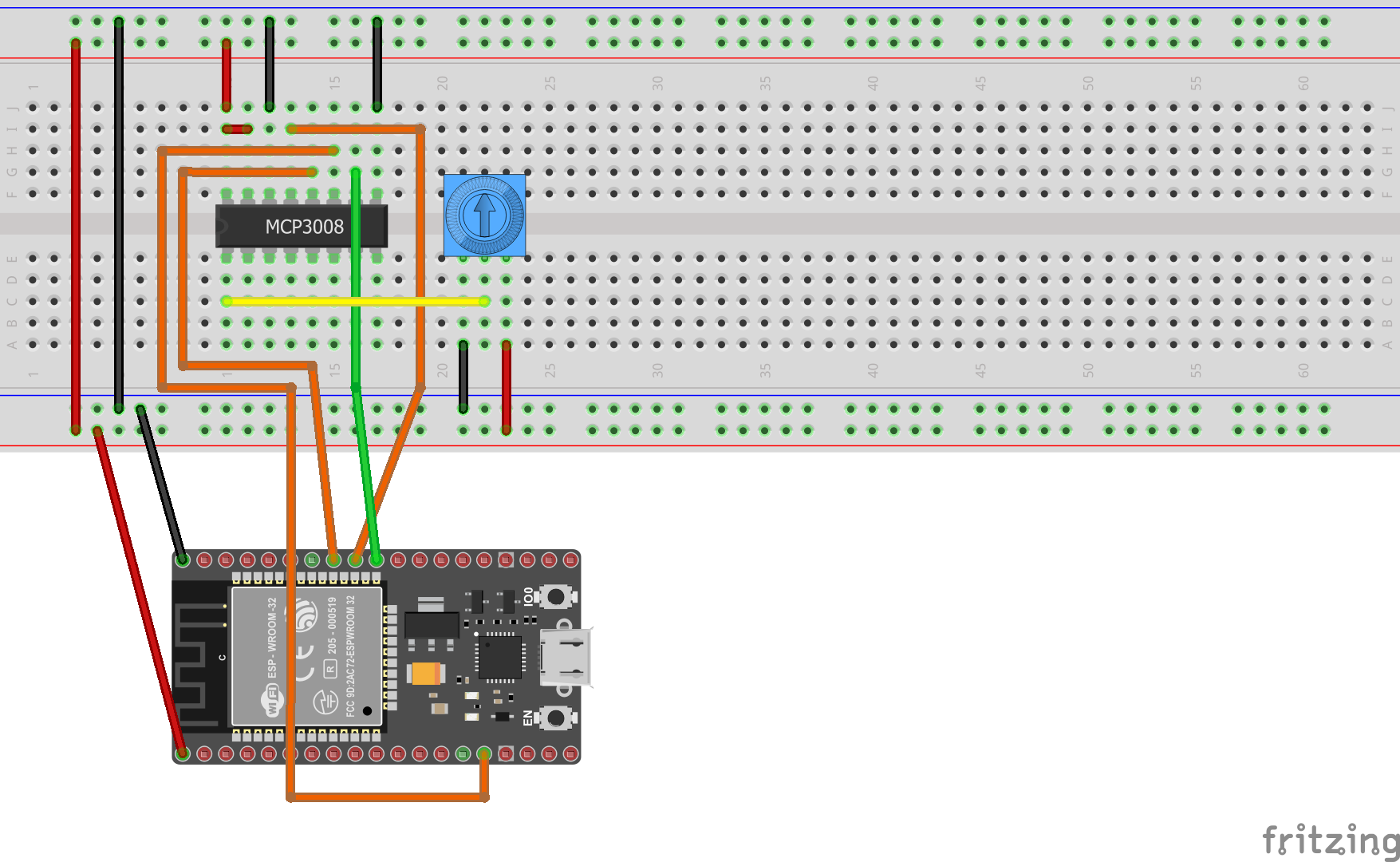MCP3001/MCP3002/MCP3004/MCP3008/MCP3201/MCP3202/MCP3204/MCP3208/MCP3301/MCP3302/MCP3304 family of Analog to Digital Converters
Some devices like the Raspberry Pi cannot read analog values directly so rely on analog to digital converters, like the ones available from Microchip in the Mcp3000, Mcp3200 and Mcp3300 ranges. These chips can be accessed as an SPI device or manually via raw GPIO pins. Normally all MCU has an analogic capability but the number of pins can be limited. This is typically useful when you want your MCU to have more than the number of ADC available. Another case is if you need a different resolution or voltage reference.
You can use these converters in your project to access analog devices.
The following fritzing diagram illustrates one way to wire up the Mcp3008, with an ESP32 and a potentiometer.

Documentation
The sample is based on following resources:
- Analog Inputs for Raspberry Pi Using the MCP3008
- Raspberry Pi Analog to Digital Converters.
- Raspbery Pi Analog Input with MCP3008
- MCP3008.py
Major thanks to Adafruit for providing python implementations, which were ported to C# for this sample.
Usage
Important: make sure you properly setup the SPI pins especially for ESP32 before creating the SpiDevice, make sure you install the nanoFramework.Hardware.ESP32 nuget:
//////////////////////////////////////////////////////////////////////
// when connecting to an ESP32 device, need to configure the SPI GPIOs
// used for the bus
Configuration.SetPinFunction(21, DeviceFunction.SPI1_MOSI);
Configuration.SetPinFunction(22, DeviceFunction.SPI1_MISO);
Configuration.SetPinFunction(23, DeviceFunction.SPI1_CLOCK);
// Make sure as well you are using the right chip select
For other devices like STM32, please make sure you're using the preset pins for the SPI bus you want to use. The chip select can as well be pre setup.
Hardware elements
The following elements are used in this sample:
Accessing the MCP3008 via SPI
The MCU has support for SPI.
You can use the following code to access the MCP3008 via hardware SPI:
var hardwareSpiSettings = new SpiConnectionSettings(1, 42)
{
ClockFrequency = 1000000
};
using (SpiDevice spi = SpiDevice.Create(hardwareSpiSettings))
using (Mcp3008 mcp = new Mcp3008(spi))
{
while (true)
{
double value = mcp.Read(0);
value = value / 10.24;
value = Math.Round(value);
Debug.WriteLine($"{value}%");
Thread.Sleep(500);
}
}
The following pin layout can be used:
- MCP3008 VDD to MCU 3.3V
- MCP3008 VREF to MCU 3.3V
- MCP3008 AGND to MCU GND
- MCP3008 DGND to MCU GND
- MCP3008 CLK to MCU SCLK
- MCP3008 DOUT to MCU MISO
- MCP3008 DIN to MCU MOSI
- MCP3008 CS/SHDN to MCU CE0

Accessing the MCP3008 via GPIO
You can also access the MCP3008 via GPIO pins, implementing SPI manually. This method is referred to as bit-banging.
You can use the following code to access the MCP3008 via GPIO:
using (SpiDevice spi = new SoftwareSpi(clk: 18, miso: 23, mosi: 24, cs: 25))
using (Mcp3008 mcp = new Mcp3008(spi))
{
while (true)
{
double value = mcp.Read(0);
value = value / 10.24;
value = Math.Round(value);
Debug.WriteLine($"{value}%");
Thread.Sleep(500);
}
}
The following pin layout can be used:
- MCP3008 VDD to MCU 3.3V
- MCP3008 VREF to MCU 3.3V
- MCP3008 AGND to MCU GND
- MCP3008 DGND to MCU GND
- MCP3008 CLK to any valid GPIO on the MCU
- MCP3008 DOUT to any valid GPIO on the MCU
- MCP3008 DIN to any valid GPIO on the MCU
- MCP3008 CS/SHDN to any valid GPIO on the MCU

Processing the data
Independent of the way in which you access the MCP3008 chip, the code to process its results is the same, which follows.
while (true)
{
double value = mcp.Read(0);
value = value / 10.24;
value = Math.Round(value);
Debug.WriteLine(value);
Thread.Sleep(500);
}
The chip is 10-bit, which means that it will generate values from 0-1023 (recall that 2^10 is 1024). We can transform the value to a more familiar 0-100 scale by dividing the 10-bit value by 10.24.
Remarks
These bindings support the following ADC's
Mcp3001 10 bit resolution with a single pseudo-differential input.
Mcp3002 10 bit resolution with two single ended inputs or a single pseudo-differential input.
Mcp3004 10 bit resolution with four single ended inputs or two single pseudo-differential inputs.
Mcp3008 10 bit resolution with eight single ended inputs or four single pseudo-differential inputs.
Mcp3201 12 bit resolution with a single pseudo-differential input.
Mcp3202 12 bit resolution with two single ended inputs or a single pseudo-differential input.
Mcp3204 12 bit resolution with four single ended inputs or two single pseudo-differential inputs.
Mcp3208 12 bit resolution with eight single ended inputs or four single pseudo-differential inputs.
Mcp3301 13 bit signed resolution with a single true differential input.
Mcp3202 12 bit resolution with four single ended inputs or 13 bit signed resolution with two true differential inputs.
Mcp3304 12 bit resolution with eight single ended inputs or 13 bit signed resolution with four true differential inputs.
Note: Currently untested on the Mcp33xx family.